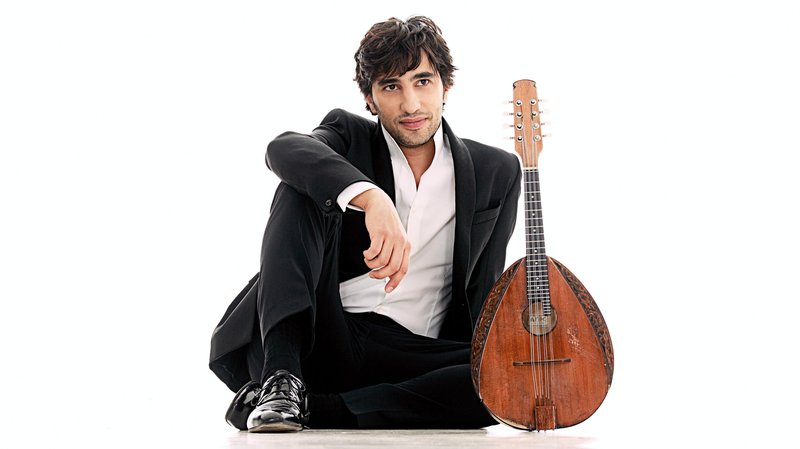San Diego Symphony Goes for Baroque with Mandolin Virtuoso Avi Avital
Although the mandolin as a featured solo instrument is not one that symphony audiences regularly encounter, younger virtuosi such as Chris Thile and Avi Avital are beginning to turn that around. Avital’s mastery of virtuoso concertos by J. S. Bach and Antonio Vivaldi with the San Diego Symphony Saturday (December 8) easily persuaded the Copley Symphony Hall audience that this humble stringed instrument holds its own admirably with an adroitly proportioned contingent of the orchestra.
Avital made his own transcription of Bach’s well-known D Minor Harpsichord Concerto, BWV 1052. Perhaps because the harpsichord is also a plucked stringed instrument, the transcription proved more than felicitous. And Sebastian Bach would have been the last composer to complain about making transcriptions, since he freely made solo organ transcriptions of violin concertos and other orchestral works by Vivaldi, Torelli and Albinoni for himself and his sons to enjoy performing.

Avi Avital [photo courtesy of the San Diego Symphony]
I was less persuaded by Avital’s version Vivaldi’s “Winter” Concerto in F Minor from the The Four Seasons, although the performer’s technical facility was applied with equal aplomb as in his Bach concerto. Although Avital amazingly produced all the notes in Vivaldi’s rapid high figurations, I missed the violin’s silvery continuity that gives these lines their steely definition. And in the Largo, we simply heard too much plucking, with pizzicato upper strings accompanying the mandolin’s plucked melody.
In transcribing portions of The Four Seasons, however, Avital is hardly exceptional. Even a small flurry of research came up with versions of this Vivaldi favorite played by exotic groups including a Japanese koto orchestra, an ensemble of traditional Chinese instruments, and a Canadian early music group that integrated a Chinese pipa, Indian sarangi and Inuit throat-singing.
The rest of the DeBus program proved eclectic in a less than satisfying way, although his choice of Stravinsky’s “Divertimento” from his large ballet Le Baiser de la feé could not have been more welcome. A Stravinsky score that is all too frequently overlooked, this 1928 ballet combines a wealth of themes taken from Tchaikovsky’s songs and piano music but placed in Stravinsky’s own austere textures and juxtaposed one after the other in his terse, abrupt modernist style. Debus suavely guided the orchestra through these tricky maneuvers, and the orchestra gave an aptly rambunctious, edgy account of this clever, unpredictable outing. According to the printed program, the only other time the San Diego Symphony performed Stravinsky’s “Divertimento” from this ballet was in the 1964-65 season.
Anton Arensky’s “Variations on a Theme by Tchaikovsky” was written as an homage to the great Russian composer, but it verges on an overly reverent academic exercise, in part because Arensky chose not to vary the the theme but rather repeat it in different settings and tempos. Debus gave the work a thoughtfully considered interpretation, and the symphony strings responded with their warmest, most glowing sonority and polished phrasing. But that could not keep me from glancing at my watch, vainly hoping for quick relief.
The less said about Benjamin Britten’s orchestration of Henry Purcell’s four-voiced Chaconne in G Minor, the better. Like other English musicians of his generation, Britten was overjoyed to discover an English Baroque composer, but his generation had no concept of period performance. So Britten’s grandiose, overblown setting sounds like something Purcell might have written had he been reincarnated as Ralph Vaughan Williams. This piece brought to mind those overwrought orchestrations of Bach organ works by Leopold Stokowski. Enough, thank you.
Anatol Liadov’s shimmering tone poem “The Enchanted Lake” for full orchestra, an early 20th-century work trying to find its way between lush Wagnerian textures and misty Impressionist understatement, provided an apt, delicately performed prelude to the Stravinsky “Divertimento.”
This concert by the San Diego Symphony was performed at the Jacobs Music Center’s Copley Symphony Hall on December 7 & 8, 2018. The December 8 performance was attended for this review.

Ken Herman, a classically trained pianist and organist, has covered music for the San Diego Union, the Los Angeles Times’ San Diego Edition, and for sandiego.com. He has won numerous awards, including first place for Live Performance and Opera Reviews in the 2017, the 2018, and the 2019 Excellence in Journalism Awards competition held by the San Diego Press Club. A Chicago native, he came to San Diego to pursue a graduate degree and stayed.Read more…


